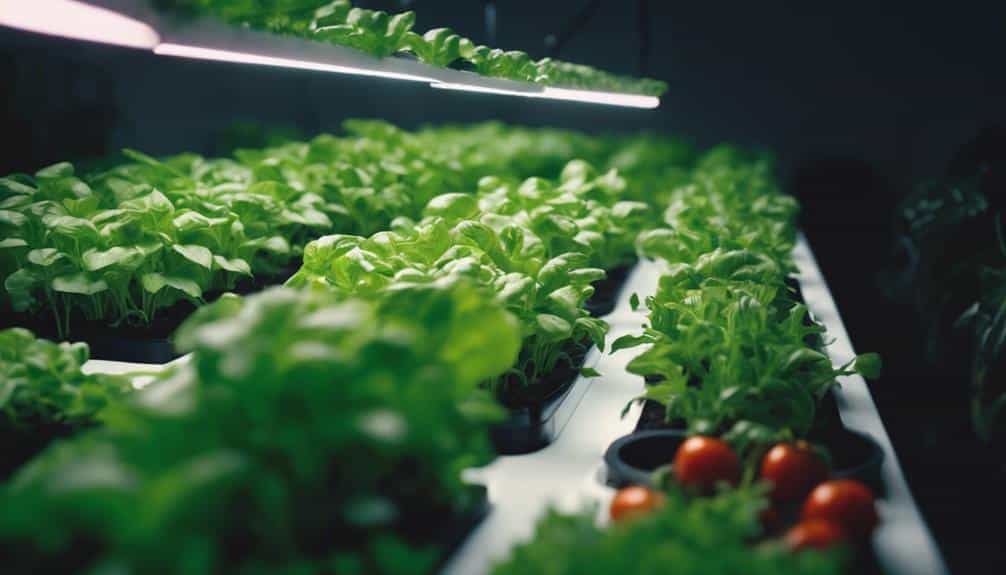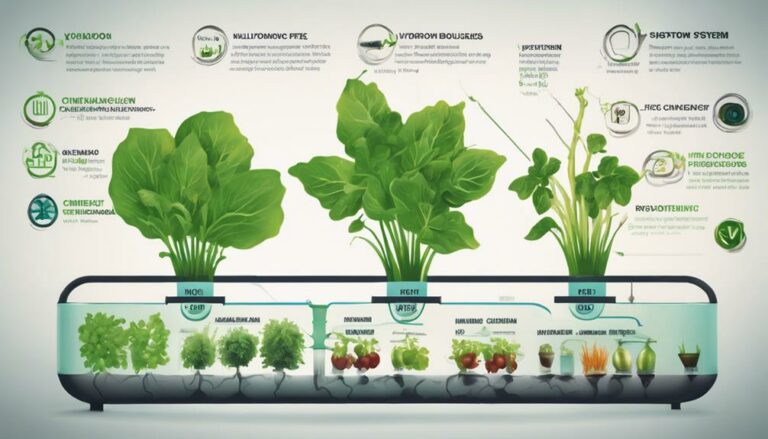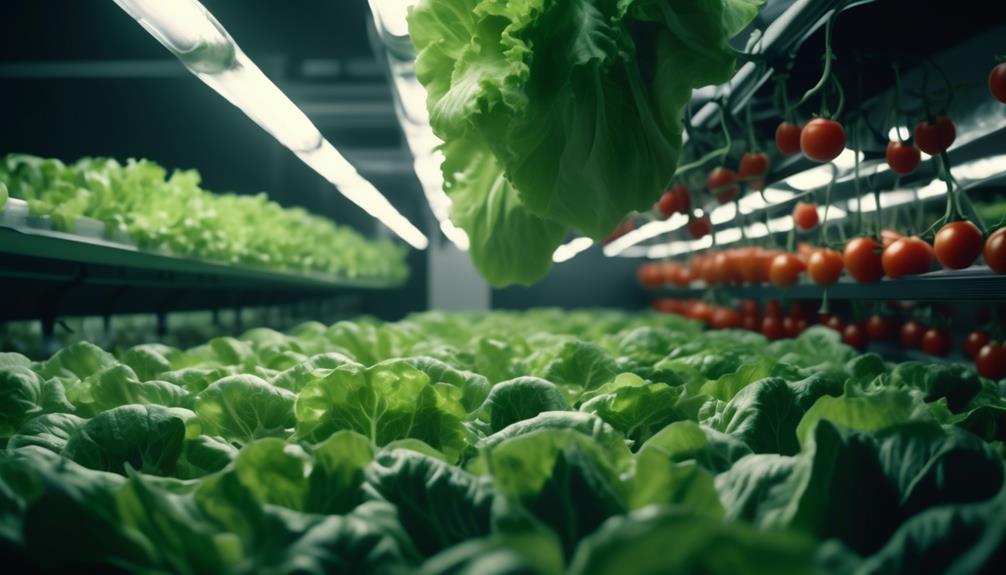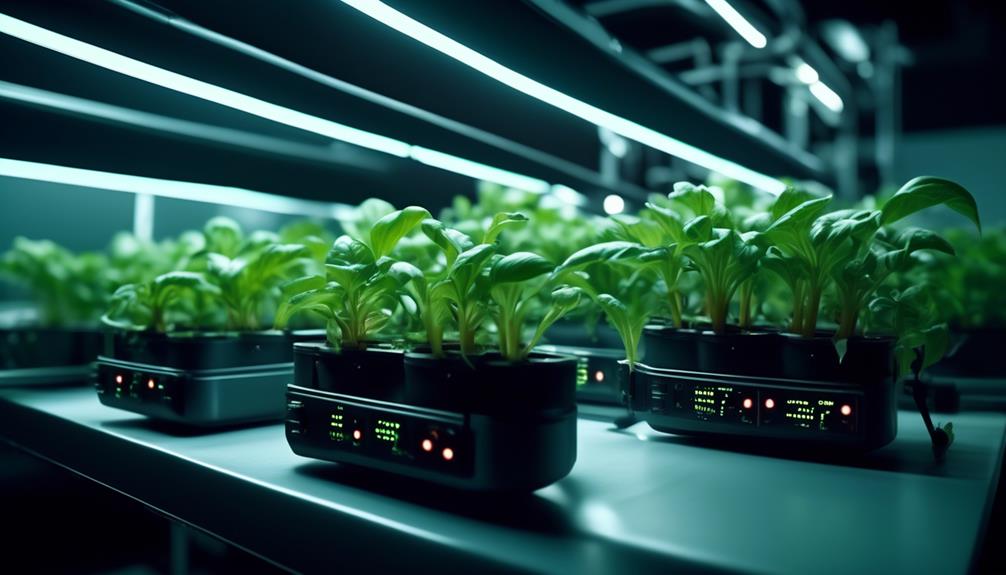Table of Contents
Hydroponics transforms gardening, showcasing how lettuce, spinach, kale, tomatoes, and peppers thrive without soil. Imagine your kitchen brimming with fresh, crisp cucumbers and green beans, thanks to the magic of hydroponics. But it’s not just about vegetables; herbs like basil, mint, and cilantro can add zest to any dish with their intensified flavors. Don’t forget about fruits; strawberries and even root veggies like radishes find their place in hydroponic systems. Given the right setup, these crops flourish, turning gardening into a year-round pursuit of freshness and sustainability. Curious about mastering this method? There’s plenty more to uncover that might inspire your next green venture.
Key Takeaways
- You can grow a variety of leafy greens including lettuce, spinach, and kale in hydroponic systems.
- Hydroponics is suitable for cultivating flavorful herbs such as basil, mint, and cilantro, offering intense aromas and tastes.
- Fruit and vegetable crops like tomatoes, peppers, cucumbers, and strawberries thrive in hydroponic environments.
- Root vegetables, including radishes and carrots, can be grown hydroponically with precise adjustments in nutrient delivery and space.
- Innovative plant choices for hydroponics include alpine strawberries, Chinese string eggplants, and rainbow chard, expanding cultivation possibilities.
Essential Hydroponic Crops
In the field of hydroponics, certain crops such as lettuce, spinach, kale, tomatoes, hot peppers, cucumbers, and green beans are considered essential due to their adaptability and ease of cultivation in water-based environments. These versatile plants not only thrive in the unique conditions of hydroponic systems but also promise a bounty of fresh produce for those who cultivate them.
Tomatoes, with their need for ample light, and hot peppers, such as jalapeños and habaneros, bring a spicy kick to the hydroponic garden, showcasing the diversity of crops that can be grown in these systems. Meanwhile, cucumbers, including the popular American slicers, excel in hydroponic setups, offering crisp, invigorating fruits that are as satisfying to grow as they are to eat.
Green beans, known for their high productivity and low maintenance, round out the list of essential hydroponic crops. These plants exemplify the efficiency and sustainability of hydroponic farming, providing ample yields with minimal fuss. For those interested in the innovative world of hydroponics, these crops offer a solid foundation upon which to build a diverse and thriving garden.
Leafy Greens Mastery
Building upon the foundation of versatile hydroponic crops, mastering the cultivation of leafy greens like arugula, kale, and collard greens represents a significant advancement in optimizing nutrient-dense and culinary diverse hydroponic gardening. These plants not only thrive in a hydroponic setting but also bring a plethora of health benefits to the table. Rich in vitamins, minerals, and antioxidants, leafy greens are powerhouses of nutrition, aiding digestion, and potentially reducing cholesterol levels.
The culinary pairings for these greens are as diverse as their health benefits. Imagine the invigorating zest of citrus fruits, the crunch of nuts, and the pungency of garlic and onions, all enhancing the natural flavors of these greens. Whether it’s a revitalizing salad, a hearty wrap, a smoothie packed with goodness, or a warm soup, leafy greens are versatile in cooking, adapting to various culinary creations.
Moreover, the tips for utilizing these greens are boundless. From transforming kale into crispy chips, using them as natural wraps for proteins, to incorporating them in colorful salads for a nutritional boost, leafy greens are truly the stars of hydroponic systems, offering both culinary diversity and health benefits.
Flavorful Herbs Guide
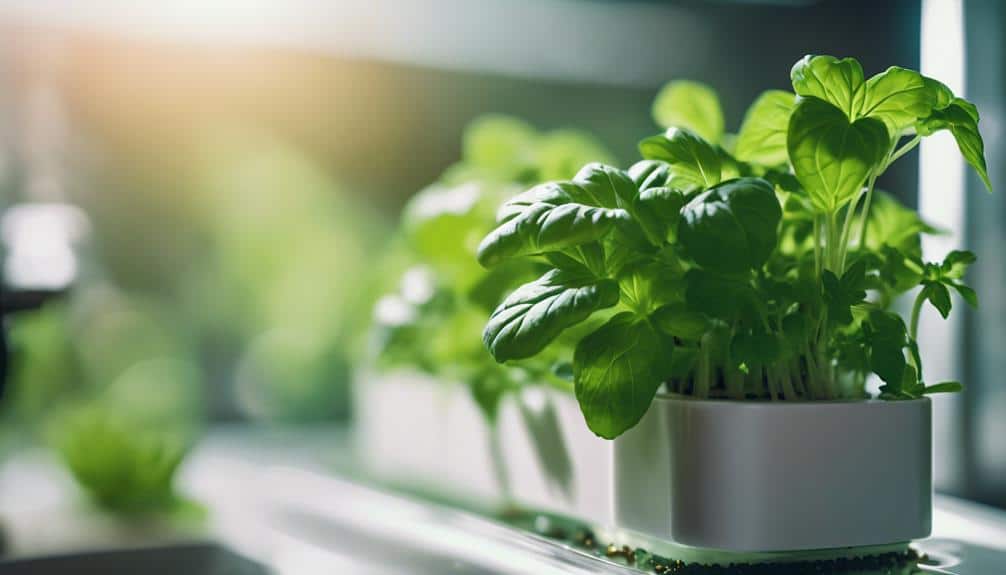
Shifting from leafy greens, our focus moves to the aromatic world of herbs in our hydroponic garden. Understanding the selection of ideal herbs such as basil, mint, and cilantro, and knowing how to maximize their growth, can greatly enhance the flavor profile of our culinary creations.
With the right approach, we can guarantee a continuous supply of fresh, aromatic herbs that elevate dishes from good to extraordinary, making every meal an adventure in taste.
Selecting Ideal Herbs
Selecting the ideal herbs for your hydroponic garden, such as basil and mint, hinges on understanding their unique flavor profiles and growth requirements. Herbs like these are superb picks for hydroponic systems due to their fresh and intense flavors that elevate any dish.
Hydroponically grown herbs boast more flavorful and aromatic qualities than their store-bought counterparts, providing a sensory feast for both the nose and palate. The controlled environment of hydroponic systems guarantees peak growth and flavor development, enabling year-round availability of fresh herbs.
This not only makes your cooking endeavors more convenient but also turns every meal into an aromatic journey. By harvesting herbs just before use, you optimize the ultimate taste and aroma, ensuring your dishes are always a cut above.
Maximizing Herb Growth
Maximizing the growth of herbs such as basil and mint in hydroponic systems involves precise control over nutrients and environmental conditions to guarantee the highest quality and flavor. Hydroponically grown herbs are not only more flavorful and fresh compared to their store-bought counterparts but also allow for year-round culinary use. Here’s how to make sure your herbs thrive:
- Constant Monitoring: Keep an eye on pH levels and nutrient concentrations.
- Optimal Lighting: Ensure your herbs receive the right amount and type of light.
- Timely Harvesting: Pick herbs just before use to enhance dish flavors significantly.
Adopting hydroponic systems for growing herbs like basil and mint can revolutionize your culinary experiences, providing a continuous supply of fresh, flavorful herbs directly from your home.
Fruitful Ventures
Exploring the domain of hydroponics reveals an abundant potential for cultivating a diverse array of fruits, enhancing both sustainability and food security. This innovative approach to agriculture allows for the year-round production of fresh produce, regardless of external climate conditions. Among the champions of hydroponic cultivation are staples such as lettuce, tomatoes, and peppers, alongside the sweet delight of strawberries. These crops not only thrive in a controlled environment but also herald a new era of food production that is resilient, efficient, and bountiful.
Moreover, the versatility of hydroponics extends to the nurturing of mustard greens, bok choy, and chard, showcasing the system’s capacity to support a wide spectrum of nutritional and flavorful options. This method empowers growers to produce millions of servings of leafy greens annually, leveraging vertical farming techniques for an ideal use of space. The result? An impressive array of fruits and vegetables that promise a future where food scarcity is a thing of the past, and healthy, sustainable eating is within everyone’s reach.
As we continue to innovate within the domain of hydroponics, the possibilities for what we can grow are only bound by our imagination.
Root Vegetables Insights
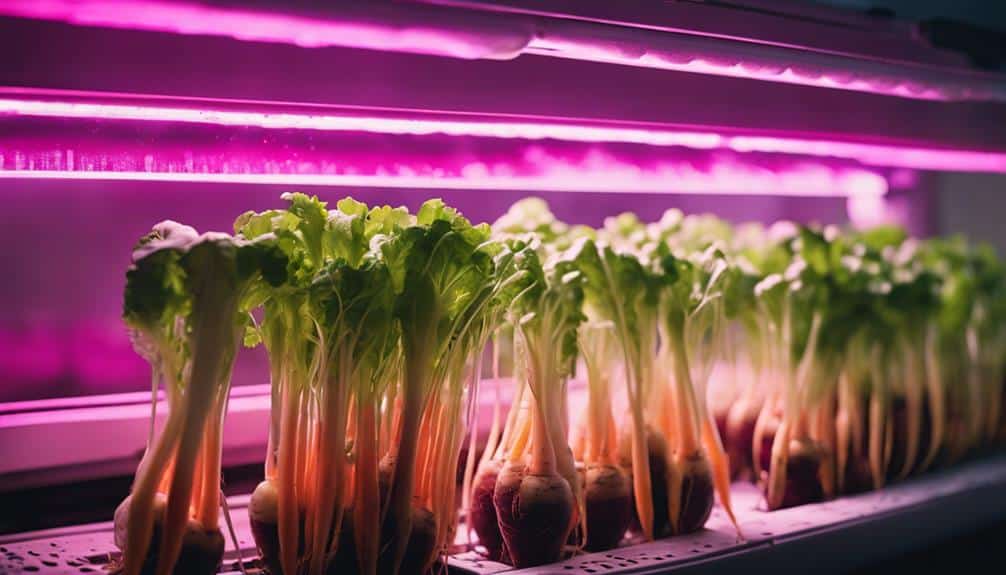
Moving on from the successful ventures of hydroponic gardening, we now delve into the fascinating world of root vegetables.
While they present unique challenges due to their specific growth requirements and space needs, innovative hydroponic setups have enabled the successful cultivation of varieties like radishes.
Understanding the delicate balance of nutrients and water management is key to nurturing these underground treasures, promising a harvest that might surprise you with its distinct flavors and textures.
Root Vegetable Challenges
Root vegetables such as potatoes, carrots, and beets pose significant challenges in hydroponic systems due to their unique growth requirements and need for substantial space. Integrating these root staples into a hydroponic garden demands more than just enthusiasm; it requires innovation and a willingness to adapt traditional methods. Key hurdles include:
- The extensive root systems that struggle in the confined vertical spaces of standard hydroponic setups.
- A need for significant modifications to typical systems designed for leafier greens or herbs.
- The imperative for careful planning and precise adjustments in nutrient delivery to guarantee these subterranean gems flourish.
Addressing these challenges head-on, with an eye for detail and a commitment to experimentation, can turn the dream of a hydroponically grown root vegetable garden into a lush, productive reality.
Optimal Growing Conditions
Having outlined the challenges associated with growing root vegetables hydroponically, it is now pertinent to examine the conditions under which these crops can thrive.
| Factor | Requirement |
|---|---|
| pH Levels | 6.0 to 6.5 |
| Environment | Controlled |
| Space | More than leafy greens |
| Nutrient Delivery | Proper |
| System Type | Hydroponic |
In the innovative world of hydroponics, root vegetables such as carrots, radishes, and beets can flourish under ideal conditions. Achieving the right pH levels between 6.0 and 6.5 is essential for their growth. Hydroponic systems excel in providing controlled environments, ensuring that these subterranean treasures receive the precise nutrient delivery they require. However, they do ask for a bit more elbow room compared to their leafy counterparts, emphasizing the importance of space requirements for successful cultivation.
Innovative Plant Choices
Exploring innovative plant choices, hydroponic systems offer a unique opportunity to grow a variety of crops, including some less common options that thrive in this soilless cultivation method. For those seeking to diversify their hydroponic garden, the following plants not only bring variety but also pack a punch when it comes to visual appeal, taste, and nutritional value:
- Alpine strawberries: Known for their delicate flavor, these berries can move from hydroponic systems to outdoor permaculture settings, offering versatility and sustainability.
- Chinese string eggplants: These vibrant, elongated eggplants are a must-try for hydroponic enthusiasts. Their self-pollinating nature makes them an effortless addition, simplifying the pollination process.
- Rainbow chard: With its stunning, colorful stems, rainbow chard is not just a feast for the eyes but also a nutritional powerhouse, rich in antioxidants.
Mustard greens and dwarf pea varieties also make exceptional candidates for hydroponic cultivation. Mustard greens require space to flourish, while dwarf peas keep growth manageable and are self-pollinating, making them perfect for beginners and those with limited space. Engaging with these innovative plant choices in hydroponic systems not only broadens the spectrum of what you can grow but also enriches your gardening experience with unique flavors and aesthetics.
Hydroponic System Selection
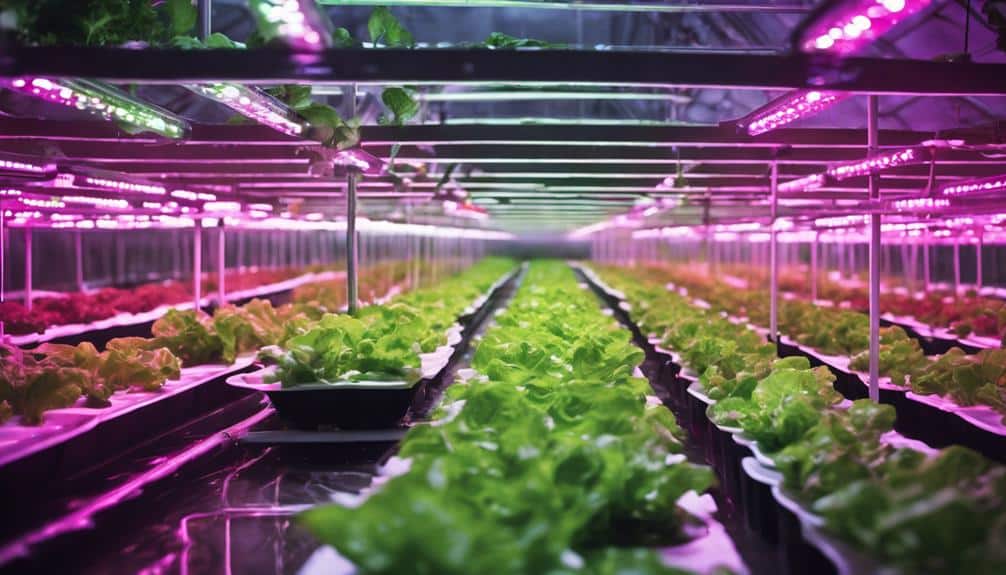
After examining innovative plant choices for hydroponic gardening, the next step involves selecting the suitable hydroponic system to guarantee maximum growth and yield. Different hydroponic systems cater to various plant needs, greatly influencing your garden’s success. Whether you desire lush leafy greens for your kitchen or aim to yield a lot from fruit-bearing plants, understanding the relationship between the hydroponic system, plants to grow, and their root systems is paramount.
| Hydroponic System | Best Suited Plants |
|---|---|
| NFT (Nutrient Film Technique) | Leafy greens and herbs with shallow root systems |
| DWC (Deep Water Culture) | Larger root system plants like tomatoes and peppers |
| Aeroponics | Plants requiring high oxygen levels like strawberries and cucumbers |
Choosing the right system ensures your plants thrive under best growing conditions, enhancing both growth and yield. For plants for kitchen use like herbs and lettuce, the NFT system provides a constant flow of nutrient-rich water, ensuring they receive everything necessary for rapid growth. On the other hand, the DWC system supports robust root development for tomatoes and peppers, essential for a bountiful harvest. Meanwhile, aeroponics maximizes oxygen exposure, promoting healthy root systems for strawberries and cucumbers, ensuring they flourish in your hydroponic environment.
Frequently Asked Questions
What Cannot Be Grown Hydroponically?
Plants facing root depth challenges, requiring intricate pest management strategies, or presenting nutritional balance issues may not thrive hydroponically. Considerations also include water usage efficiency, space constraints, energy consumption, and climate control complexities.
What Are the Best Things to Grow Hydroponically?
The best candidates for hydroponic cultivation include leafy greens, various herb varieties, diverse tomato types, cucumber options, and strategies for strawberry cultivation. Additionally, pepper plants and edible flowers excel in these innovative systems, offering robust yields.
What Is the Most Profitable Thing to Grow Hydroponically?
Evaluating market trends analysis, cost efficiency strategies, energy consumption insights, global demand forecasts, nutrient solution optimization, growth cycle acceleration, and investor interest evaluation reveals that leafy greens represent the most profitable hydroponic crop due to their rapid growth and high demand.
Which Crop Is Best for Hydroponic Farming?
The ideal crop for hydroponic farming integrates system types, precise nutrient solutions, stringent water quality, pH level management, tailored lighting conditions, strategic plant spacing, and understanding growth cycle variations to optimize yield and efficiency.
Conclusion
To sum up, the domain of hydroponic gardening offers a vast array of opportunities for growing a diverse selection of crops, from the essential leafy greens and flavorful herbs to the more ambitious endeavors of fruits and root vegetables.
Additionally, it encourages exploration into innovative plant choices, all while guiding the selection of the most suitable hydroponic system.
This method of cultivation not only optimizes space and resources but also invites enthusiasts to engage with agriculture in an environmentally conscious and sustainable manner.

